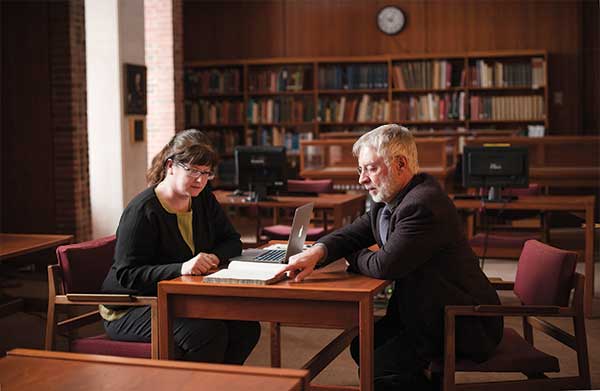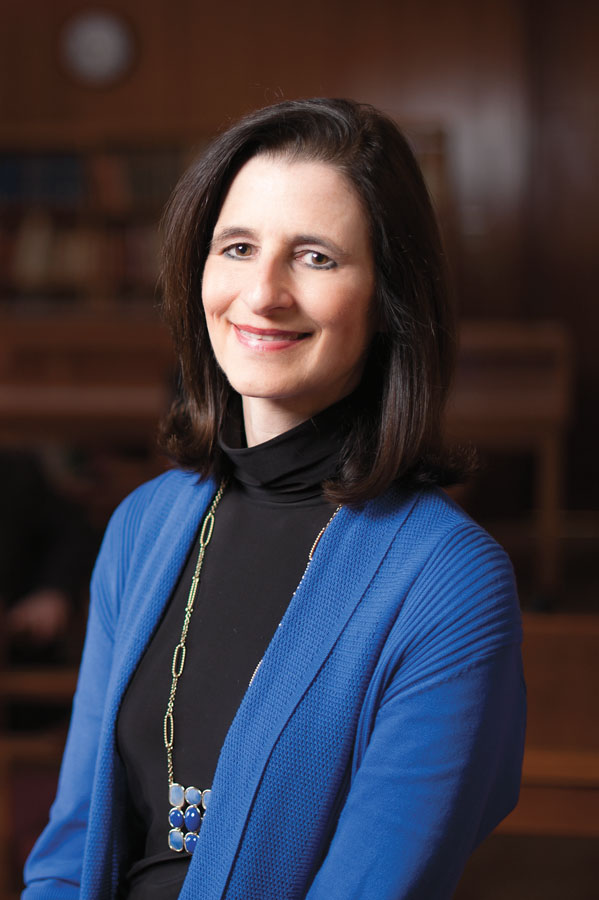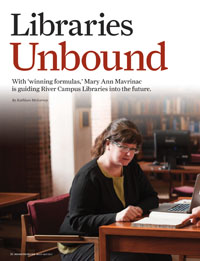Features
 SEWARD STEWARDS: Students of history professor Thomas Slaughter (right), including film preservation graduate student Heather Harkins (left), are digitizing the papers of the William Seward family. An archival collection, the papers will now be broadly accessible—a development characteristic of the 21st-century library. (Photo: Adam Fenster)
SEWARD STEWARDS: Students of history professor Thomas Slaughter (right), including film preservation graduate student Heather Harkins (left), are digitizing the papers of the William Seward family. An archival collection, the papers will now be broadly accessible—a development characteristic of the 21st-century library. (Photo: Adam Fenster)For a glimpse at the future of libraries, at Rochester and beyond, you might want to consult the papers of William Henry Seward. Yes, that Seward—secretary of state to presidents Lincoln and Johnson.
A collection spanning the years 1730 to 1917—public, private, and family correspondence of Seward and his family members, files and records from his long political career as governor and secretary, speeches, diaries, and other documents—was given to Rochester by Seward’s son, William Henry Seward III between 1945 and 1951. Now students of Thomas Slaughter, the Arthur R. Miller Professor of History, are bringing those papers into the digital age, transcribing and coding them to make them accessible to scholars, students, and curious readers anywhere in the world. The class—a two-course sequence, The Seward Family’s Civil War and The Seward Family in Peace and in War—meets in the Libraries’ Department of Rare Books and Special Collections. Designed for undergraduate and graduate students, the course combines traditional efforts of historians—among them, transcribing, editing, and annotating primary historical documents—with intellectual tasks for the digital age: creating and implementing the Seward Project, a website collection of digitized Seward family photos and documents.
Slaughter teaches the class in conjunction with manuscript librarian Lori Birrell; film studies librarian and director of the Digital Humanities Center, Nora Dimmock; and Melissa Mead, the John M. and Barbara Keil University Archivist and Rochester Collections librarian. They have met not only in a conventional classroom and in Rare Books and Special Collections but also in a digital humanities computer lab in the Janis and James S. Gleason Library. “It’s the first time the library has had a collaboration on this scale between its different units and between faculty and students,” Slaughter says. The course has drawn history majors, computer science and engineering majors interested in technological applications, and master’s students from the Selznick Graduate Program in Film and Media Studies at the George Eastman House who are interested in expanding their knowledge of film preservation to encompass manuscript preservation.
“They’re working with our content, and learning from the expertise of faculty members and librarians. They’re learning technological skills—and it’s embedded in the curriculum. That’s a winning formula, and that’s what our future is in working with students,” says Mary Ann Mavrinac, the new vice provost and Andrew H. and Janet Dayton Neilly Dean of River Campus Libraries.
 CONNECTIONS: Mary Ann Mavrinac, the new Neilly Dean of the River Campus Libraries, calls libraries “a convergence space, connecting the content.” (Photo: Adam Fenster)
CONNECTIONS: Mary Ann Mavrinac, the new Neilly Dean of the River Campus Libraries, calls libraries “a convergence space, connecting the content.” (Photo: Adam Fenster)A leader in the creation of learning spaces and the development of digital services, Mavrinac brings a decade of experience as chief librarian at the University of Toronto’s Mississauga campus, part of the University of Toronto Libraries, the third largest library system in North America. She was formally installed in the deanship in December, though she began her work at Rochester last summer.
Larry Alford, chief librarian of the University of Toronto, says Mavrinac is “very innovative. She wants to experiment and achieve a high level of excellence for the library in teaching and learning.”
“She doesn’t grandstand,” says Anne Kenney, the Carl A. Kroch University Librarian at Cornell. “She comes out with quite thought-provoking and forward-moving approaches.”
Slaughter attests that Mavrinac’s presence is already strongly felt. “She’s contributing to an atmosphere where collaboration is encouraged and supported, and she’s brought creativity to making that collaboration possible in our project.”
Mavrinac comes to Rochester at a significant moment in the modern history of libraries. “I don’t know if I would call this a pivotal point—it’s a constant evolution that’s actually accelerating,” she says, pointing to “an unrelenting march in terms of technological change and innovation, and the broader environmental trends that, really more than anything, are having an impact on libraries.” Her response is both pragmatic and confident: “We could see them as threats—or we can look at these as opportunities to allow us to really engage and collaborate with our constituencies: faculty, students, the broader community, other research institutions and academic libraries, and other cultural organizations.”
The River Campus Libraries—the largest component of the University’s library system, along with the Medical Center’s Edward G. Miner Library, the Eastman School’s Sibley Music Library, and the Memorial Art Gallery’s Charlotte Whitney Allen Library—hold more than 3 million books in print and electronic formats, more than 40,000 active journal titles, and microforms, videos, and other formats. It’s Mavrinac’s task, and that of her colleagues, to help students and faculty make the best use of those resources and navigate an information landscape that, increasingly, exists on a screen as much as in a physical building.
University libraries have changed significantly in the past decade and a half. “If you were a student 15 years ago and you reentered academia, you’d say it’s all different,” says Suzanne Bell, the business librarian in the Business and Government Information Library. Increasingly, libraries are social hubs on campuses. Food and drink, once forbidden, are now not just permitted but actually for sale on the premises, all in a quest to create a welcoming and comfortable environment for patrons. Digitization is one of the most obvious and far-reaching changes, as libraries become increasingly concerned with information itself and less devoted to the physical objects that contain it.
The most vivid shift in academic libraries between 2004 and 2010 was the number of e-books they hold in their collections—from 32.8 million to 158.7 million, according to data released in 2011 by the U.S. Department of Education. Spending on print books and other non-journal printed materials fell in the same period by nearly 20 percent when adjusted for inflation, from $550.6 million to $515.9 million. According to a report on the data in Inside Higher Education, one thing that has held steady, however, is teaching information literacy—though as of 2010, only 20 percent of institutions with a strategic plan for information literacy included libraries in the effort.
It is that kind of disconnect that Mavrinac has already worked to overcome.
Formerly, a library “really was a siloed organization in many ways,” she says, bound up in the collection and preservation of printed documents. For even something as simple as an address for somewhere beyond the scope of one’s local phonebook, a library was the place to go—a “vertical, hierarchical means by which people obtained information.”
The Internet, of course, changed all that. “It’s definitely what we would call a ‘killer app,’ ” she says, something with “the power to alter the marketplace, alter how fundamental business occurs. The telephone did that, and the automobile. It changes the whole marketplace, in many cases for the better. And that’s what the web was.”
Cornell’s Kenney says that in the wake of the web, the role of libraries on campuses “isn’t as self-evident as it once was. It’s a more complex environment.”
The key to adapting, for librarians and users alike, is to focus on content rather than format, says Dimmock. “A book, a physical book, is a format. Is it the content that matters? Being a film librarian, I’ve always had to think about those issues. In my back room, I have 16 millimeter. I have laser discs. I have VHS. I have DVD—and now even DVD is dead. They’re just containers. It’s the content.”
And moving away from that materiality is “a new service model,” she says. “We’ve very much organized around collections, and we have to change the way we think about collections.” As digitization brings greater uniformity to libraries’ collections—publishers sell journals, databases, and other resources in bundles, much like cable companies do channels—rare books and manuscripts take a special place. “I think that the collections that are going to matter the most to libraries are the special collections, because those are the unique things,” says Dimmock.
While the Internet has made address-hunting trips to the library unnecessary, students’ need for guidance in navigating libraries’ resources is only growing more acute. Students today “have been using technology since they were toddlers,” says Toronto’s Alford, but they don’t necessarily understand how academic information searching works. “There’s extraordinary complexity of information access and discovery.”
The flexibility of digital holdings makes them more convenient—there’s no need to put on your shoes and hike to the library when you can search databases in your pajamas from the comfort of your own couch—but their intangibility is also an obstacle, Mavrinac says.
Libraries “used to be storage, a warehouse medium with user spaces—and now we’re almost a convergence space, connecting the content. When things are electronic, students don’t necessarily know what’s available. When you walk into the stacks, you can see the books—you may not know which ones you need, but there they are, and you’re probably pretty sure you can find the right ones with some help.” But when those resources are intangible, findable only through well-informed digital sifting, the librarian becomes even more essential. “It’s a big role for us, to connect those dots,” she adds.
Students like Caitlin Mack ’13 (T5), of Essex, Vt., find themselves using the library in both its new and old forms. “I like getting books occasionally. I enjoy the aesthetics of it,” says Mack. But her practical side has taken a shine to electronic editions. “I appreciate the convenience of having everything on my laptop.”
Yet students at Rochester crowd the library, as they do at campuses across the country. For Mack, the library is a place to gather as much as it is to work; in fact, the two functions are intertwined. “I find the environment there is a lot more conducive to studying” than working alone in her room, she says. “People go for the atmosphere—you see people doing their work, and you get to see your friends.”
As libraries and their resources increasingly become virtual, what becomes of the physical spaces they inhabit? Mavrinac calls it an area “of profound opportunity.” At one level, the library fosters interaction—and that draws students. Like most people, “they’re hungry for human contact, human connections,” she says.
But Mavrinac is convinced that the library works best when it is more than a gathering space. “We’re evolving our learning spaces,” she says, and the evolution turns on “the integration of technology, not for technology’s sake, but technology that’s meaningful for the task at hand.”
To look at libraries solely as study spaces, she says, doesn’t provide students with the support they need. “Students might come here and think all they need to do is find a table and hang out while they do their studying, but I think it’s incumbent on us to step that up a level and provide them with a higher level of support. They might say, this is all I need, but when you present them with alternatives, it’s really of interest to them.”
She cites the Rare Books and Special Collections project as one example of how library space, technology, expertise, and curriculum can come together. She has experience from Toronto, where she oversaw the creation of an award-winning academic learning center that attracts more than 1.3 million visits per year.
“It’s the connection of program, content, expertise, spaces, and technology that I think is a winning formula,” she says. “You’re basically turning students away at the door when you get into that kind of perfect alignment with the curriculum and with the program.” Learning spaces are increasingly being built with a specific need in mind.
The Finance Learning Center at the Mississauga library is an example. “It was almost like a company involved in trades,” Mavrinac says. The setting was designed by faculty to work with their pedagogy, and the center was directed by a librarian with a background in finance. Toronto business leaders and bankers would visit to talk to students and judge their trading competitions. Financial literacy programs were offered for college and high school students.
As they map out a strategy for Rochester, Mavrinac and her colleagues are determined to make the libraries a collaborative hub of innovation—not just for student learning but also for faculty research.
A Center for Digital Scholarship, proposed by Mavrinac, would support that collaboration, with expertise, advice, support, and technological tools and resources for scholars and students engaged in digital humanities.
Such models have taken hold in scientific fields. The impact of the digital era is felt more deeply in the sciences, where “e-science” first emerged two decades ago. Scientists collaborate with colleagues in labs across the globe, and the quantities of data they are amassing are transforming data storage and preservation methods.
“Everything we do revolves around what scientists do. And scientists are now doing research in a totally different way,” says Zari Kamarei, the Somerville Director of the Carlson Science and Engineering Library. Curating data, storing it securely, and making it accessible to users are what she sees as her library’s core tasks.
Mavrinac also sees opportunities in the shift to a more collaborative approach. She’s confident that libraries—and librarians—will be at the forefront. Technological developments allow libraries to “operate not just with the output of scholarship but with the entire scholarship process, and the entire learning process,” she says. “We can be deeply engaged with student learning, enable their use of technology, embed different literacies in the curriculum. Working with faculty, we can support the life cycle of scholarly research and new modes of scholarship, like digital humanities and e-science. We can be technological hubs for the academy. We didn’t have these roles before,” Mavrinac says.
“We are transitioning to a digital future, whether we like it or not. There are broad and pervasive trends that no library can duck, and they’re informing how we go about our business.”

